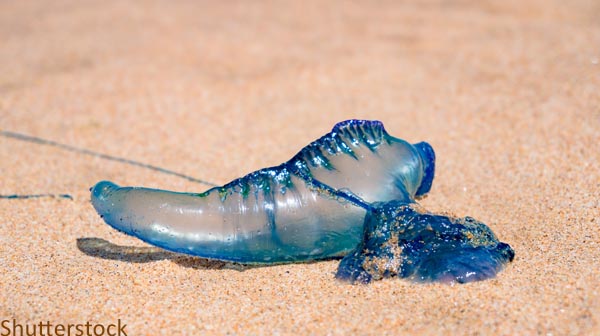
Caveats: Contrary to previous studies in mice, verapamil has been shown to be ineffective and possibly detrimental; it exacerbated cardiovascular symptoms and increased mortality in pigs.9,10,13–16 Additionally, felodipine and magnesium sulfate may actually worsen the effects of the venom, but further research is needed. C. fleckeri stings can be deadly, however, recent data suggest the fatality rate is actually much lower than the roughly 20 percent that was previously reported.6,13,17 Morbidity and mortality are dose- and time-dependent, which explains why the majority of deaths have been in children.12,18 Avoid treating with fresh water, alcohol, methylated spirits, and urine, as these have also been shown to increase nematocyst firing.19
Irukandji jellyfish (Carukia barnesi)
Location: Northern and western Australia; cases of Irukandji-like syndrome have been reported in the southeast United States and Hawaii20,21
Appearance: Small bell that measures less than 2–3 cm in diameter with four tentacles measuring up to 1 m in length.
Pathophysiology and Symptoms: Most commonly causes local inflammation and erythema. Symptoms can progress to a sympathomimetic toxidrome-like presentation called Irukandji syndrome, which usually develops within two hours of envenomation and can last up to two days.1,22 This rare but serious complication manifests in diverse ways (eg, chest, abdominal, and back pain, myalgias/severe muscle spasm, headache, vomiting, and diaphoresis). In severe toxicity, exposure can lead to hypertensive crisis with nonspecific ECG abnormalities, elevated cardiac biomarkers, cardiogenic pulmonary edema, intracranial hemorrhage, and death.
Management: Manage pain with vinegar and HWI. IV magnesium sulfate (0.2 mmol/kg, max 10 mmol in adults) bolused over 5–15 mins can be used for pain refractory to opioids (and it also theoretically will help with hypertension), however, data are limited and efficacy has not been established. If there is concern for Irukandji syndrome: stat ECG, serial cardiac biomarkers, echocardiography, chemistry panel, and/or CT of the head without contrast. Hypertension should be treated with short-acting, titratable medications (eg, phentolamine, esmolol, nitroprusside, nicardipine) due to potential for hypotension in the later stages of toxicity.1
Class: Hydrozoa
Portuguese Man-of-War (Physalia physalis and Physalia utriculus)
Location: Atlantic, Indian, and Pacific Oceans
Epidemiology: Approximately 10,000 stings from Physalia spp. are recorded each year in Australia.23
Appearance: Physalia species are considered siphonophores, meaning they are composed of multiple smaller organisms acting together as a single colony. P. physalis has a sail-shaped, bluish-purple pneumatophore (the origin of their alternative name “Bluebottle”) that floats on the surface and can be inflated and deflated for flotation and submersion purposes. The pneumatophore ranges from a few inches to one foot in diameter and houses up to 40 tentacles that can reach a length of greater than 30 m.1 P. utriculus has a similar appearance but has only one tentacle that measures about 15 m in length.1
Pages: 1 2 3 4 5 | Single Page





No Responses to “Emergen-Sea Medicine: Overview of Marine Envenomations”